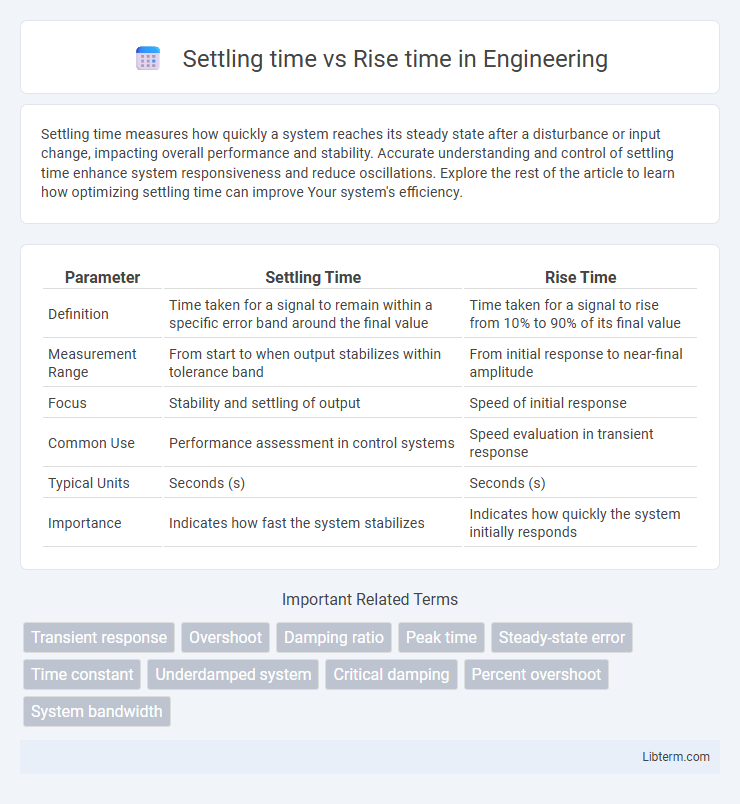Settling time measures how quickly a system reaches its steady state after a disturbance or input change, impacting overall performance and stability. Accurate understanding and control of settling time enhance system responsiveness and reduce oscillations. Explore the rest of the article to learn how optimizing settling time can improve Your system's efficiency.
Table of Comparison
| Parameter | Settling Time | Rise Time |
|---|---|---|
| Definition | Time taken for a signal to remain within a specific error band around the final value | Time taken for a signal to rise from 10% to 90% of its final value |
| Measurement Range | From start to when output stabilizes within tolerance band | From initial response to near-final amplitude |
| Focus | Stability and settling of output | Speed of initial response |
| Common Use | Performance assessment in control systems | Speed evaluation in transient response |
| Typical Units | Seconds (s) | Seconds (s) |
| Importance | Indicates how fast the system stabilizes | Indicates how quickly the system initially responds |
Introduction to Settling Time and Rise Time
Settling time measures how long a system takes to remain within a specific error band around its final value after a disturbance, reflecting stability and response precision. Rise time quantifies the duration required for a system's response to transition from a lower to a higher percentage of its final value, indicating speed of initial reaction. Both metrics are crucial in control systems and signal processing, optimizing performance and ensuring accurate tracking of desired outputs.
Defining Settling Time
Settling time is the duration required for a system's response to remain within a specified error band around its final value after a disturbance or input change. It quantifies how quickly the output stabilizes without significant oscillations or deviations outside the tolerance range. Unlike rise time, which measures the interval to reach a certain percentage of the final value, settling time emphasizes the steady-state accuracy and stability of the response.
Understanding Rise Time
Rise time measures the duration a system's response takes to transition from a specified low percentage (commonly 10%) to a high percentage (commonly 90%) of its final steady-state value. It is a critical parameter in control systems and signal processing for evaluating the speed of a system's initial response to a step input. Understanding rise time helps engineers optimize system performance by balancing responsiveness and overshoot to ensure efficient and stable operation.
Key Differences Between Settling Time and Rise Time
Settling time is the duration a system takes to remain within a specified error band around the final value, while rise time measures the time for the response to go from a lower percentage (typically 10%) to a higher percentage (typically 90%) of that final value. Settling time focuses on steady-state accuracy and stability, whereas rise time emphasizes the speed of the initial response. These metrics serve distinct purposes in control systems and signal processing performance evaluation.
Importance in Control Systems
Settling time and rise time are critical parameters in control systems that determine system performance and stability. Settling time measures how quickly a system reaches and remains within a desired output range, reflecting the system's ability to minimize oscillations and steady-state error. Rise time indicates the speed at which a system responds to a change, impacting the responsiveness and transient behavior of controllers in applications such as robotics and industrial automation.
Factors Influencing Settling Time
Settling time depends on factors such as system damping ratio, natural frequency, and the presence of external disturbances, which influence how quickly a system stabilizes after a transient response. Higher damping ratios generally reduce overshoot and oscillations, shortening settling time, while low damping leads to prolonged oscillations and increased settling duration. System stiffness and feedback control parameters also play critical roles in determining the settling time by affecting the dynamic response and stability margins.
Factors Affecting Rise Time
Rise time is influenced by system bandwidth, input signal characteristics, and component response speed, determining how quickly a system responds initially. Higher bandwidth and faster components reduce rise time, leading to quicker transitions from low to high states. External factors such as load capacitance and signal noise also affect rise time by slowing the system's ability to reach the target value.
Applications in Signal Processing
Settling time measures how long a system takes to reach and stay within a specified error band after a disturbance, while rise time quantifies the duration for a signal to transition from a low to a high threshold, typically 10% to 90% of its final value. In signal processing applications such as filter design and amplifier response, optimizing rise time ensures rapid signal transitions for accurate timing, whereas minimizing settling time guarantees signal stability for precise measurements. Balancing these parameters enhances performance in real-time systems, data acquisition, and communication signal integrity.
Common Mistakes in Interpretation
Confusing settling time with rise time is a common mistake in control system analysis, as rise time measures how quickly a signal initially reaches a target value while settling time indicates how long it takes to remain within a specified error band. Misinterpreting these parameters can lead to inaccurate assessments of system stability and performance, especially in feedback loops and transient response. Engineers often overlook that a short rise time does not guarantee a short settling time, which can result in underestimating oscillations or overshoot behavior.
Optimizing System Performance Using Time Response Metrics
Settling time and rise time are critical time response metrics for optimizing system performance in control engineering. Minimizing rise time ensures faster initial response, while reducing settling time guarantees the output stabilizes quickly within a desired error band. Balancing these parameters improves overall stability and responsiveness of dynamic systems, enhancing efficiency and precision in applications such as robotics, automation, and signal processing.
Settling time Infographic

 libterm.com
libterm.com